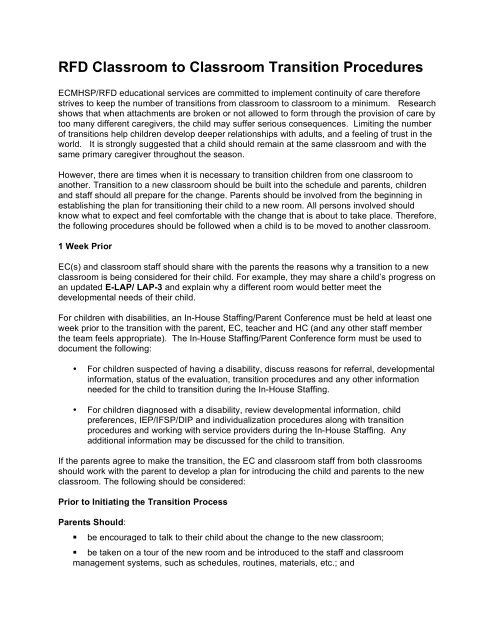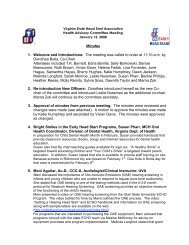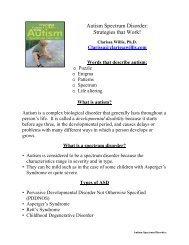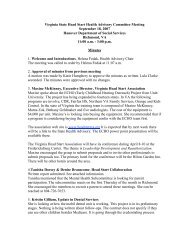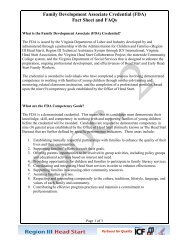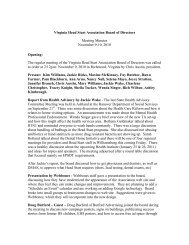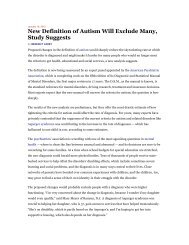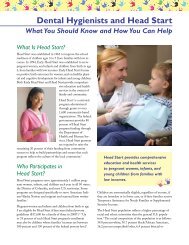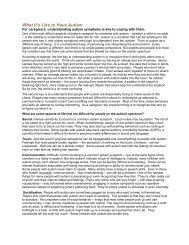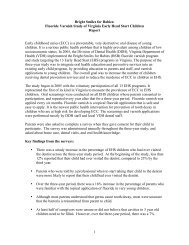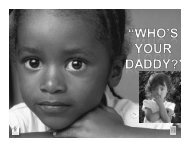RFD Classroom to Classroom Transition Procedures
RFD Classroom to Classroom Transition Procedures
RFD Classroom to Classroom Transition Procedures
You also want an ePaper? Increase the reach of your titles
YUMPU automatically turns print PDFs into web optimized ePapers that Google loves.
<strong>RFD</strong> <strong>Classroom</strong> <strong>to</strong> <strong>Classroom</strong> <strong>Transition</strong> <strong>Procedures</strong><br />
ECMHSP/<strong>RFD</strong> educational services are committed <strong>to</strong> implement continuity of care therefore<br />
strives <strong>to</strong> keep the number of transitions from classroom <strong>to</strong> classroom <strong>to</strong> a minimum. Research<br />
shows that when attachments are broken or not allowed <strong>to</strong> form through the provision of care by<br />
<strong>to</strong>o many different caregivers, the child may suffer serious consequences. Limiting the number<br />
of transitions help children develop deeper relationships with adults, and a feeling of trust in the<br />
world. It is strongly suggested that a child should remain at the same classroom and with the<br />
same primary caregiver throughout the season.<br />
However, there are times when it is necessary <strong>to</strong> transition children from one classroom <strong>to</strong><br />
another. <strong>Transition</strong> <strong>to</strong> a new classroom should be built in<strong>to</strong> the schedule and parents, children<br />
and staff should all prepare for the change. Parents should be involved from the beginning in<br />
establishing the plan for transitioning their child <strong>to</strong> a new room. All persons involved should<br />
know what <strong>to</strong> expect and feel comfortable with the change that is about <strong>to</strong> take place. Therefore,<br />
the following procedures should be followed when a child is <strong>to</strong> be moved <strong>to</strong> another classroom.<br />
1 Week Prior<br />
EC(s) and classroom staff should share with the parents the reasons why a transition <strong>to</strong> a new<br />
classroom is being considered for their child. For example, they may share a child’s progress on<br />
an updated E-LAP/ LAP-3 and explain why a different room would better meet the<br />
developmental needs of their child.<br />
For children with disabilities, an In-House Staffing/Parent Conference must be held at least one<br />
week prior <strong>to</strong> the transition with the parent, EC, teacher and HC (and any other staff member<br />
the team feels appropriate). The In-House Staffing/Parent Conference form must be used <strong>to</strong><br />
document the following:<br />
• For children suspected of having a disability, discuss reasons for referral, developmental<br />
information, status of the evaluation, transition procedures and any other information<br />
needed for the child <strong>to</strong> transition during the In-House Staffing.<br />
• For children diagnosed with a disability, review developmental information, child<br />
preferences, IEP/IFSP/DIP and individualization procedures along with transition<br />
procedures and working with service providers during the In-House Staffing. Any<br />
additional information may be discussed for the child <strong>to</strong> transition.<br />
If the parents agree <strong>to</strong> make the transition, the EC and classroom staff from both classrooms<br />
should work with the parent <strong>to</strong> develop a plan for introducing the child and parents <strong>to</strong> the new<br />
classroom. The following should be considered:<br />
Prior <strong>to</strong> Initiating the <strong>Transition</strong> Process<br />
Parents Should:<br />
<br />
be encouraged <strong>to</strong> talk <strong>to</strong> their child about the change <strong>to</strong> the new classroom;<br />
be taken on a <strong>to</strong>ur of the new room and be introduced <strong>to</strong> the staff and classroom<br />
management systems, such as schedules, routines, materials, etc.; and
eceive explanation about how the moving <strong>to</strong> the new room will benefit their child(ren).<br />
Receiving <strong>Classroom</strong> Staff Should:<br />
designate a cubby/s<strong>to</strong>rage space for the new child and label it with the child’s name and<br />
picture;<br />
<br />
<br />
add the child <strong>to</strong> the lesson plan, meal chart and attendance sheet;<br />
plan a “Welcome <strong>to</strong> our room” activity for the first day the child comes <strong>to</strong> visit; and<br />
talk <strong>to</strong> the other children about the new child who will be joining the group and a<br />
pho<strong>to</strong>graph of the child can be shared with the children.<br />
<br />
Ask for any allergy or special dietary needs documentation<br />
Current <strong>Classroom</strong> Staff Should:<br />
prepare the items listed on the Child <strong>Classroom</strong> <strong>Transition</strong> Form so that all<br />
information is ready for transfer when the child leaves;<br />
share information about the child with the receiving classroom staff prior <strong>to</strong> the child<br />
visiting on the first day;<br />
relay <strong>to</strong> the child’s new lead teacher whether a child has an IEP or IFSP and if s/he<br />
should be given guidance from ECMHSP specialists and professionals working with the<br />
child;<br />
provide the child a pho<strong>to</strong>graph of the receiving staff as well as her/his own pho<strong>to</strong>graph <strong>to</strong><br />
carry with them on the visit; and<br />
make up a simple song about the move and talk <strong>to</strong> the child about the visit. Staff might<br />
also use puppets and other activities <strong>to</strong> act out going <strong>to</strong> a new classroom.<br />
<br />
Provide allergy or and special dietary needs documentation<br />
The Parent, New and Current Caregivers, EC, Center Direc<strong>to</strong>r and Family<br />
Services Coordina<strong>to</strong>r should:<br />
sign the Child <strong>Classroom</strong> <strong>Transition</strong> Form indicating that they were involved in the<br />
planning for the transition of the child <strong>to</strong> another classroom.<br />
Week of <strong>Transition</strong><br />
Day 1: Arrange for the child <strong>to</strong> visit the receiving room during free choice play with her/his<br />
primary caregiver.<br />
Day 2: Arrange for the child <strong>to</strong> visit the receiving room during free choice play and outdoor play<br />
with his/her primary caregiver.<br />
Day 3: Arrange for the child <strong>to</strong> visit the receiving classroom during free choice play, outdoor play<br />
and through lunch, with the primary caregiver only visiting the child during lunch. Make sure the<br />
transitioning child is only counted 1 time during the meal count.<br />
Day 4: Arrange for the child <strong>to</strong> visit the receiving classroom during free choice play, outdoor<br />
play, lunch and naptime. The primary caregiver will visit at naptime only if the child indicates a<br />
need <strong>to</strong> see her/him.
Day 5: Arrange <strong>to</strong> have the child completely transitioned <strong>to</strong> the new classroom. At this time the<br />
current caregiver should move the child’s possessions <strong>to</strong> the receiving classroom as well as<br />
notify transportation staff, if applicable, of transition. It is recommended that very young children<br />
be placed in a room that they can stay in for the season because of their need <strong>to</strong> have a<br />
consistent, primary caregiver in order for them <strong>to</strong> bond and develop trust and security.<br />
However, there are times when it is necessary <strong>to</strong> transition a child under the age of two <strong>to</strong><br />
another room. In these cases, it is suggested that several visits of 15-30 minutes per day be<br />
scheduled with the primary caregiver one week prior <strong>to</strong> transition and 30-45 minutes visits be<br />
scheduled the week of the transition, with the primary caregiver gradually weaning out of the<br />
child’s time in the receiving room. Special considerations need <strong>to</strong> be made when transitioning<br />
children birth <strong>to</strong> 24 months of age as well as children with special needs.<br />
As stated previously, it is recommended that very young children be placed in a room where<br />
they can stay in for the season because of their need <strong>to</strong> have a consistent, primary caregiver in<br />
order for them <strong>to</strong> bond and develop trust and security. Because relationship building is so<br />
important in caring for young children, unnecessary transitions should be avoided. Planning for<br />
very young children <strong>to</strong> stay in one room for the season allows for continuity of care minimizing<br />
transitions from classroom <strong>to</strong> classroom allowing children and their primary caregivers <strong>to</strong> build<br />
that relationship. Infants and <strong>to</strong>ddlers coming in<strong>to</strong> the center should be able <strong>to</strong> stay with their<br />
primary caregivers for as long as possible before transitioning in<strong>to</strong> another classroom.<br />
Following <strong>Transition</strong> Week<br />
The bond formed between children and the primary caregivers from their first room needs <strong>to</strong> be<br />
respected. This bond is not <strong>to</strong> be severed simply because children are moved <strong>to</strong> a new room.<br />
To preserve the connection, there should be ongoing opportunities for children <strong>to</strong> maintain<br />
contact through warm greetings and brief visits from the primary caregiver <strong>to</strong> children’s new<br />
room.<br />
Child <strong>Classroom</strong> <strong>Transition</strong> Form<br />
Purpose<br />
• To ensure that classroom <strong>to</strong> classroom transitions occur in a timely, predictable and<br />
unrushed manner according <strong>to</strong> the child’s developmental needs.<br />
• To ensure parents and relevant staff participate in easing the child’s transition <strong>to</strong> another<br />
classroom.<br />
Instructions<br />
When a child is developmentally ready <strong>to</strong> be transitioned <strong>to</strong> another classroom, this form<br />
provides the appropriate steps <strong>to</strong> follow for the child’s emotional stability during the transition<br />
process.<br />
• Discuss the process with parents. Upon their approval, fill in the form and plan for the<br />
transition.<br />
• Parents and relevant staff need <strong>to</strong> sign as active participants in the process.<br />
• Date each item as the process is followed.<br />
The form is filed in the child’s folder once the process is completed.<br />


